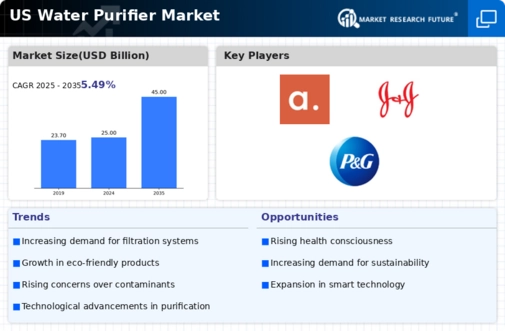Growing Awareness of Water Quality
The increasing awareness regarding water quality issues is a primary driver in the water purifier market. Consumers are becoming more informed about contaminants present in tap water, such as lead, chlorine, and bacteria. This heightened awareness is prompting individuals to seek effective purification solutions. According to recent data, approximately 70% of households in the US express concerns about their drinking water quality. As a result, the demand for water purifiers is expected to rise, with the market projected to reach $3 billion by 2026. This trend indicates a shift towards prioritizing health and safety, thereby significantly impacting the water purifier market.
Technological Advancements in Filtration
Technological innovations in filtration systems are transforming the water purifier market. Advanced technologies, such as reverse osmosis, UV purification, and multi-stage filtration, are enhancing the efficiency and effectiveness of water purifiers. These innovations not only improve the quality of purified water but also cater to diverse consumer needs. For instance, the introduction of smart water purifiers, which offer real-time monitoring and maintenance alerts, is gaining traction. The market for these advanced systems is anticipated to grow at a CAGR of 10% over the next five years, reflecting the increasing consumer preference for high-tech solutions in the water purifier market.
Rising Urbanization and Population Density
Urbanization and increasing population density are pivotal factors driving the water purifier market. As more individuals migrate to urban areas, the demand for clean and safe drinking water intensifies. Urban centers often face challenges related to water quality due to aging infrastructure and pollution. Consequently, households in these regions are more inclined to invest in water purification systems to ensure access to safe drinking water. The water purifier market is projected to expand significantly, with urban areas accounting for over 60% of total sales by 2027. This trend underscores the critical need for effective water purification solutions in densely populated regions.
Regulatory Support for Clean Water Initiatives
Regulatory frameworks aimed at ensuring clean drinking water are significantly influencing the water purifier market. Government initiatives and policies that promote water safety and quality standards are driving consumers towards purchasing purification systems. For example, the Environmental Protection Agency (EPA) has established guidelines that encourage households to utilize water purification technologies. This regulatory support is likely to bolster market growth, as compliance with safety standards becomes a priority for consumers. The water purifier market is expected to benefit from these initiatives, with an estimated growth rate of 8% annually as more households invest in purification solutions.
Consumer Preference for Convenience and Portability
The growing consumer preference for convenience and portability is reshaping the water purifier market. With busy lifestyles, individuals are increasingly seeking compact and easy-to-use purification solutions. Portable water purifiers, such as bottle filters and countertop systems, are gaining popularity among consumers who prioritize convenience. This shift is particularly evident among millennials and urban dwellers who value products that fit seamlessly into their daily routines. The market for portable water purifiers is expected to witness a growth rate of 12% over the next few years, indicating a strong trend towards convenience-driven solutions in the water purifier market.














Leave a Comment